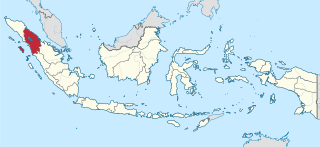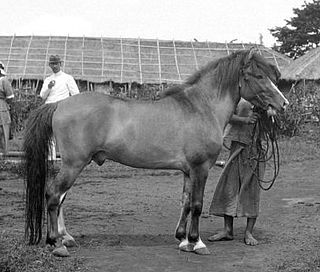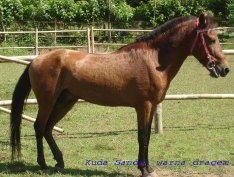Related Research Articles

Sumatra is one of the Sunda Islands of western Indonesia. It is the largest island that is fully within Indonesian territory, as well as the sixth-largest island in the world at 475,807.63 km2 (182,812 mi.2), including adjacent islands such as the Simeulue, Nias, Mentawai, Enggano, Riau Islands, Bangka Belitung and Krakatoa archipelago.

Majapahit, also known as Wilwatikta, was a Javanese Hindu-Buddhist thalassocratic empire in Southeast Asia that was based on the island of Java. It existed from 1293 to circa 1527 and reached its peak of glory during the era of Hayam Wuruk, whose reign from 1350 to 1389 was marked by conquests that extended throughout Southeast Asia. His achievement is also credited to his prime minister, Gajah Mada. According to the Nagarakretagama written in 1365, Majapahit was an empire of 98 tributaries, stretching from Sumatra to New Guinea; consisting of present-day Indonesia, Singapore, Malaysia, Brunei, southern Thailand, Timor Leste, southwestern Philippines although the scope of Majapahit sphere of influence is still the subject of debate among historians. The nature of Majapahit relations and influences upon its overseas vassals and also its status as an empire still provokes discussion.

Medan is the capital and largest city of the Indonesian province of North Sumatra. The nearby Strait of Malacca, Port of Belawan, and Kualanamu International Airport make Medan a regional hub and multicultural metropolis, acting as a financial centre for Sumatra and a gateway to the western part of Indonesia. About 60% of the economy in North Sumatra is backed by trading, agriculture, and processing industries, including exports from its 4 million acres of palm oil plantations. The National Development Planning Agency listed Medan as one of the four main central cities in Indonesia, alongside Jakarta, Surabaya, and Makassar.

North Sumatra is a province of Indonesia located on the northern part of the island of Sumatra. Its capital and largest city is Medan. It is bordered by Aceh on the northwest and Riau and West Sumatra in the southeast, with two different coastlines located on the Indian Ocean and the Strait of Malacca, and a maritime border with Malaysia to the east. North Sumatra is Indonesia's fourth most populous province after West Java, East Java and Central Java, and the third-largest province on the island of Sumatra after the neighbouring Riau. It covers an area of 72,981 km2. It is approximately the same size of Sierra Leone.

The culture of Indonesia has been shaped by long interaction between original indigenous customs and multiple foreign influences. Indonesia is centrally-located along ancient trading routes between the Far East, South Asia and the Middle East, resulting in many cultural practices being strongly influenced by a multitude of religions, including Buddhism, Christianity, Confucianism, Hinduism, and Islam, all strong in the major trading cities. The result is a complex cultural mixture, often different from the original indigenous cultures.

Pencak silat is an umbrella term for a class of related Indonesian martial arts. In neighbouring countries, the term usually refers to professional competitive silat. It is a full-body fighting form incorporating strikes, grappling, and throwing in addition to weaponry. Every part of the body is used and subject to attack. Pencak silat was practiced not only for physical defense but also for psychological ends. There are hundreds of different pencak silat styles and schools which tend to focus either on strikes, joint manipulation, weaponry, or some combination thereof.

The Bali pony is an ancient breed now living on the Indonesian island of Bali.

The Batak pony, also called the Deli pony, is a pony breed from Indonesia. Originating in Central Sumatra, it is thought to have descended from Mongolian Horse and Arabian blood, and has continually been infused with additional Arabian blood to improve its quality. The Batak is selectively breed by the Indonesians, and is often used to upgrade the quality of the horses and ponies on nearby islands.

The Sandalwood Pony is a breed of small horse originating from Indonesia, on the Sumba and Sumbawa Islands. It is named after the Sandalwood trees, which are a major export of the country. The Sandalwood pony is one of the finest in the country, partly due to the great amount of Arabian blood. They make suitable children's ponies, and have been exported to Australia for this purpose. They have also been exported to other Southeast Asian countries for use as racing ponies.

The Sumbawa Pony is a pony breed, named after the island on which they are bred, Sumbawa Island in Indonesia. This breed is very similar to the Sumba or Sandalwood Pony, a breed also developed in these islands, which came from crossing the native ponies on horses of Arabian breeding. The Sumbawa Pony descends from Mongolian Horses and ancient Chinese stock

There are 1,340 recognised ethnic groups in Indonesia. The vast majority of those belong to the Austronesian peoples, with a sizeable minority being Melanesians. Indonesia has the world's largest number of Austronesians and Melanesians.

The architecture of Indonesia reflects the diversity of cultural, historical and geographic influences that have shaped Indonesia as a whole. Invaders, colonizers, missionaries, merchants and traders brought cultural changes that had a profound effect on building styles and techniques.

Christianity is Indonesia's second-largest religion, after Islam. Indonesia also has the second-largest Christian population in Southeast Asia after the Philippines, the largest Protestant population in Southeast Asia, and the third-largest Christian population in Asia after the Philippines and China, followed by India. Indonesia also has the second-largest Christian population in the Muslim world, after Nigeria, followed by Egypt. Indonesia's 29,1 million Christians constituted 10,49% of the country's population in 2022, with 7,43% Protestant (20.6 million) and 3,06% Catholic (8.5 million). Some provinces in Indonesia are majority Christian. In Indonesia, the word Kristen refers to Protestantism, while Catholicism is referred to as Katolik. In recent times, the rate of growth and spread of Christianity has increased, especially among the Chinese minority.

The Java pony is a breed of pony developed on the island of Java in Indonesia. It is thought to have descended from wild forebears of Mongolian Wild Horse ancestry. It is larger and stronger than the Timor pony, with more Arabian breed influence.

Prehistoric Indonesia is a prehistoric period in the Indonesian archipelago that spanned from the Pleistocene period to about the 4th century CE when the Kutai people produced the earliest known stone inscriptions in Indonesia. Unlike the clear distinction between prehistoric and historical periods in Europe and the Middle East, the division is muddled in Indonesia. This is mostly because Indonesia's geographical conditions as a vast archipelago caused some parts — especially the interiors of distant islands — to be virtually isolated from the rest of the world. West Java and coastal Eastern Borneo, for example, began their historical periods in the early 4th century, but megalithic culture still flourished and script was unknown in the rest of Indonesia, including in Nias and Toraja. The Papuans on the Indonesian part of New Guinea island lived virtually in the Stone Age until their first contacts with modern world in the early 20th century. Even today living megalithic traditions still can be found on the island of Sumba and Nias.
Tassilo Adam (1878–1955) was a German ethnologist, photographer and filmmaker in what is now Indonesia. Adam photographed palaces, rulers and royal sights in Java, Indonesia. He also worked in Sumatra and other locations in the Dutch East Indies. Adam donated photographs of the Batak people and other Sumatran ethnic groups, as well as notes on central Javanese dance to the Royal Tropical Institute in Amsterdam in August 1944.

It is quite difficult to define Indonesian art, since the country is immensely diverse. The sprawling archipelago nation consists of 17.000 islands. Around 922 of those permanently inhabited, by over 1,300 ethnic groups, which speak more than 700 living languages.

The Lombok is a breed of horse found on the island of Lombok, Indonesia. Probably of Mongolian origin, this pony is influenced by horses from neighboring islands, notably Java, and is itself regularly exported to other Indonesian islands. With its height of around 1.22 m and high-legged design, the Lombok is closely related to the Macassar, a pony native to southern Sulawesi, of which it is sometimes considered a type. They are traditionally hitched to cidomo, small two-wheeled horse-drawn vehicles particularly common on the Gili Islands. They can pull heavy loads of building materials or beer. Numbers are fairly small, with around 5,000 recorded throughout Indonesia in 2003.
References
- 1 2 3 FAO Domestic Animal Diversity Information System (DAD-IS), accessed December 8, 2007
- ↑ "About the Batak-Deli breed"
- ↑ "Races de chevaux et d'équidés" Lexique du cheval! (Includes English section) Web page accessed December 8, 2007
- ↑ Boomgard, Peter (2007). "3. Horse Breeding, Long-distance Horse Trading and Royal Courts in Indonesian History, 1500–1900". Breeds of Empire: The 'Invention' of the Horse in Southern Africa and Maritime Southeast Asia, 1500–1950. Vol. 42 (NIAS studies in Asian topics). Copenhagen: NIAS. pp. 33–50. ISBN 978-8-7769-4014-0.
- ↑ Groeneveldt, Willem Pieter (1876). "Notes on the Malay Archipelago and Malacca, Compiled from Chinese Sources". Batavia: W. Bruining.
- ↑ Hendricks, Bonnie L. (1995). International Encyclopedia of Horse Breeds. University of Oklahoma Press. ISBN 9780806127538.
- ↑ Kentucky Horse Park. "Bali". Horse Breeds of the World. International Museum of the Horse. Archived from the original on 24 November 2010. Retrieved 10 November 2010.